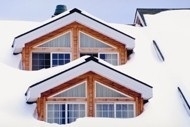 (MCT)—As the weather turns cooler, it’s time for homeowners to take prudent steps to protect their houses and property—so that the weather does not turn on them.
(MCT)—As the weather turns cooler, it’s time for homeowners to take prudent steps to protect their houses and property—so that the weather does not turn on them.
After the damage caused by last winter’s nasty weather and this year’s floods, there’s no reason to delay or to hope that nothing happens this time around.
Homeowners should “sit down and think about what some of the challenges from last winter were and try to stay ahead of those this year,” advises Dave Palmer of Palmer Brothers hardware in River Edge, N.J. “A little planning goes a long way, and it can save you money in the long run.
Let’s take a look at what can be done.
Gutters, Leaders
Ignore this, and there can be costly damage — in and out — caused by water and ice backing up from the gutters.
Gutters must be cleaned and flushed, with water running away from the home. Use a splash pan, patio block or small stones at the exit point to help disburse the water.
Fasten leaders, elbows and leader straps with hex-head screws (at least ¾-inch length; No. 8 thickness). Use caution with ladders, and if not comfortable, hire a pro.
Roofing
Inspect for missing/damaged shingles and areas that don’t look right, says Stan Reczkowski of SR Roofing in Paramus, N.J. Also, look for brownish stains at the soffit and fascia areas below gutters.
“Any repairs on the roof or above the gutter line should be done by a pro,” Reczkowski says. “Just before (Hurricane) Irene hit, while on the golf course my fellow player received a phone call that his uncle had fallen off the roof. I hear about these homeowner accidents all the time.”
Reczkowski says roofing should be done by a contractor who does nothing else but that, and adds roofers do work through the winter (weather permitting).
Chimney
Chimney sweep Keith Donaldson says to look for loose/missing bricks and mortar (the gray material between the bricks). Also check the chimney top (crown).
“You have to keep after the crown—that’s the most important part of the chimney,” warns Donaldson, of Lucky Duck’s Chimney Sweep in West Milford and River Edge. “If you don’t take care of the crown, water can penetrate.”
This is not for the weekend warrior; hire a sweep or mason. Add a cap ($125 and up) to keep debris, animals and precipitation out.
Exteriors
Homeowners who have a high-efficiency furnace that is vented out of the side of the house should make sure it is positioned so that snow does not clog those pipes, says Palmer.
Trim—often the aluminum pieces seen dangling after storms—should be secured with finishing nails.
Store outdoor furniture and toys, if possible. If not, cover with tarp and stack or lay items in such a way to minimize the chance that they will be lifted in a strong wind. Nothing, including wood piles, should come in contact with the home. Place a cover on central A/C units, and install insulated covers on water spigots.
Soil should slope away from the home to facilitate drainage. If needed, add top soil to near the foundation, then taper with a rake to create slope. Top off with landscape rock to prevent erosion.
Loose paint on wood should be scraped/sanded. Apply primer, then top coat.
Trees
Look for damaged, weak and diseased trees, which can damage power lines, homes and cars.
“Branches shouldn’t be by the chimney, period,” says Donaldson, who adds that overhanging branches give warmth-seeking animals access to winter quarters.
This is no job for amateurs. Call a reputable tree surgeon, get proof of insurance from his agent and stay indoors during the work.
©2011 The Record (Hackensack, N.J.)










